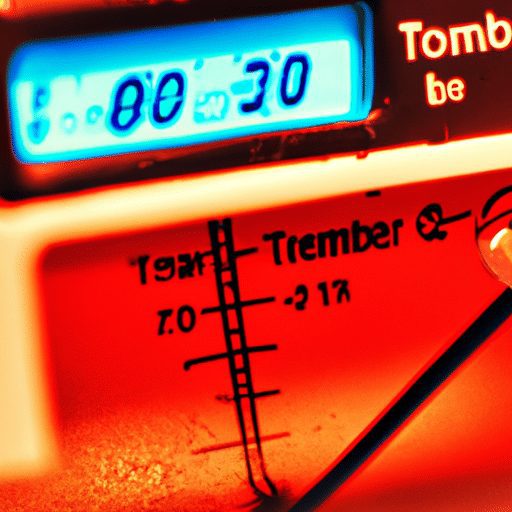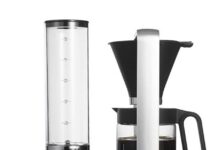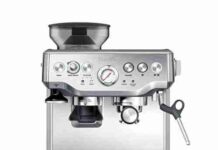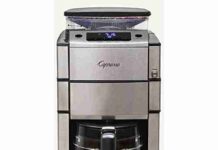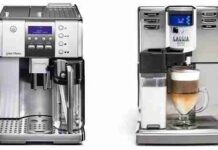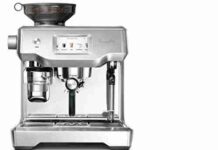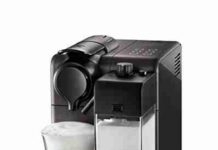Being able to determine and adjust the brew temperature on a programmable coffee maker is a seemingly small yet crucial detail that can make a significant impact on the quality and taste of your morning cup of joe. With so many variables to consider when brewing the perfect coffee, it’s essential to have control over the temperature at which your coffee is brewed. In this article, we will explore the various methods and steps involved in setting the brew temperature on a programmable coffee maker, ensuring that you can enjoy that perfect cup each and every morning.
Understanding Programmable Coffee Makers
What is a programmable coffee maker?
A programmable coffee maker is a type of coffee machine that allows you to set various parameters in advance, such as the brew temperature, brewing time, and brew strength. This allows you to have a freshly brewed cup of coffee waiting for you at a specific time, without the need for manual intervention. Programmable coffee makers offer convenience and give you more control over your coffee brewing process.
Why is temperature important in coffee brewing?
Temperature plays a crucial role in the coffee brewing process as it directly affects the extraction of flavors from the coffee grounds. Brewing coffee at the right temperature helps to achieve optimal extraction, resulting in a well-balanced and flavorful cup of coffee. If the water is too hot, it can over-extract the coffee, leading to a bitter taste. On the other hand, if the water is too cold, it may under-extract the coffee, resulting in a weak and flavorless brew. Therefore, understanding and controlling the temperature in coffee brewing is essential for achieving the perfect cup of joe.
How does a programmable coffee maker control temperature?
A programmable coffee maker controls temperature through various mechanisms. Most programmable coffee makers have built-in heating elements that heat the water to the desired temperature. These heating elements are typically adjustable, allowing you to set the brew temperature according to your preference. Some advanced models even have sensors to monitor and regulate the water temperature throughout the brewing process, ensuring consistency. Programmable coffee makers use these temperature control mechanisms to provide you with a customizable coffee brewing experience.
Factors Affecting Brew Temperature
Water temperature
The temperature of the water used in coffee brewing is critical. It is generally recommended to use water between 195°F and 205°F (90°C to 96°C) for optimal extraction. If the water is too hot, it can lead to over-extraction and a bitter taste. Conversely, if the water is too cold, it may result in under-extraction and a weak brew.
Room temperature
The ambient temperature in the room where the coffee maker is placed can indirectly affect the brew temperature. If the room temperature is significantly lower or higher than the desired brew temperature, it can impact the overall temperature of the coffee. Therefore, it is important to consider the room temperature and make necessary adjustments or select a coffee maker with temperature control features accordingly.
Type of coffee maker
Different types of coffee makers have varying temperature control capabilities. Some coffee makers have limited temperature control options, while others offer precise temperature settings. For example, manual temperature control coffee makers allow you to adjust the brew temperature manually, while pre-set temperature options coffee makers offer a range of preset temperature settings to choose from.
Coffee grind size
The grind size of the coffee grounds can also affect the brew temperature. Finer coffee grounds tend to increase the extraction rate, which may require slightly lower brew temperatures to prevent over-extraction. Coarser coffee grounds, on the other hand, may benefit from slightly higher brew temperatures to ensure proper extraction. Experimenting with different grind sizes and adjusting the brew temperature accordingly can help you find the perfect balance.
Types of Programmable Coffee Makers
Manual temperature control
Some programmable coffee makers come equipped with manual temperature control features. These coffee makers allow you to adjust the brew temperature within a certain range manually. Typically, they have a temperature adjustment button or knob that enables you to increase or decrease the temperature according to your preference. Manual temperature control coffee makers provide the flexibility to fine-tune your brew temperature for a personalized coffee experience.
Pre-set temperature options
Other programmable coffee makers offer pre-set temperature options. These coffee makers come with a menu or display that allows you to choose from a range of pre-determined temperature settings. The available temperature options may vary depending on the model. Pre-set temperature options coffee makers are convenient for those who prefer a simpler approach to temperature control without the need for manual adjustments.
Setting Temperature on Manual Control Coffee Makers
Locating the temperature adjustment button/knob
To set the temperature on a manual control coffee maker, locate the temperature adjustment button or knob. This button or knob is typically located on the front or side of the coffee maker. It may be labeled as “temperature control” or have temperature indicators for reference.
Understanding temperature range
Before adjusting the temperature, familiarize yourself with the temperature range of your specific coffee maker. The temperature range can vary between models and brands, so refer to the user manual or manufacturer’s instructions for the recommended range of your coffee maker. Knowing the temperature range will help you choose the desired temperature setting more accurately.
Adjusting the temperature
Once you have located the temperature adjustment button or knob and understood the temperature range, you can proceed to adjust the temperature. Turn the knob or press the button to increase or decrease the temperature as desired. Some coffee makers may have specific increments or markings to indicate the temperature level. Adjust the temperature gradually until you reach your preferred setting.
Setting Temperature on Pre-set Options Coffee Makers
Accessing the temperature menu
To set the temperature on a pre-set options coffee maker, you need to access the temperature menu. This can usually be done by pressing a designated button or navigating through the coffee maker’s display menu using control buttons. Refer to the user manual of your coffee maker for specific instructions on accessing the temperature menu.
Exploring available temperature options
Once you have accessed the temperature menu, you will be presented with the available temperature options. These options may be displayed as numerical values or temperature settings such as “low,” “medium,” and “high.” Take a moment to explore the available temperature options and understand their corresponding brew temperatures.
Choosing and setting the desired temperature
After familiarizing yourself with the available temperature options, choose the desired temperature setting that suits your taste preferences. Use the control buttons to navigate and select the desired temperature option. Once selected, confirm your choice, and the coffee maker will set the brew temperature accordingly. Enjoy your perfectly brewed coffee at your preferred temperature!
Calibrating Temperature Settings
Checking the accuracy of the default settings
It is advisable to check the accuracy of the default temperature settings on your programmable coffee maker. This can be done by measuring the actual temperature of the brewed coffee using a thermometer. Compare the measured temperature with the temperature displayed or set on the coffee maker. If there is a significant difference, you may need to make adjustments to calibrate the temperature settings.
Referencing a thermometer
To calibrate the temperature settings, you will need a reliable thermometer. Use the thermometer to measure the temperature of the brewed coffee as it dispenses from the coffee maker. Place the thermometer in the stream of coffee to get an accurate reading. Take note of the actual temperature measured by the thermometer for reference.
Making necessary adjustments
If the measured temperature differs from the coffee maker’s displayed or set temperature, you can make necessary adjustments to calibrate the temperature settings. For example, if the brewed coffee is consistently too hot, decrease the temperature setting by a certain increment. Conversely, if the coffee is consistently too cold, increase the temperature setting. Measure the brewed coffee temperature after each adjustment until you achieve the desired temperature accuracy.
Maintaining Optimal Brew Temperature
Cleaning the coffee maker regularly
Regular cleaning of your programmable coffee maker is essential to maintain optimal brew temperature. Over time, mineral deposits, coffee residue, and oil buildup can accumulate inside the machine, affecting its performance, including temperature control. Follow the manufacturer’s instructions for cleaning and descaling the coffee maker to ensure efficient operation and consistent brew temperature.
Checking for mineral buildup
Mineral buildup, specifically calcium and magnesium deposits, can hinder the proper functioning of the heating element in a coffee maker, leading to temperature fluctuations. Check for signs of mineral buildup, such as scaling or discoloration, and clean or descale the coffee maker accordingly. This will help to maintain the heating element’s efficiency and ensure a more accurate brew temperature.
Using filtered water
The quality of the water used in coffee brewing can impact the brew temperature. Using filtered water can help remove impurities that might affect the taste and temperature of the brewed coffee. Impurities like chlorine or minerals can alter the brew temperature or introduce off-flavors. Investing in a quality water filter or using bottled or distilled water can help maintain a consistent brew temperature and improve the overall flavor of your coffee.
Ensuring proper insulation
In addition to cleaning and maintaining the coffee maker, ensuring proper insulation can also help to maintain optimal brew temperature. Quality coffee makers often come with thermal carafes or insulated pots that keep the coffee hot for an extended period. If your coffee maker does not have built-in insulation, consider transferring the brewed coffee to an insulated container immediately after brewing to retain the desired temperature.
Troubleshooting Temperature Issues
Coffee not hot enough
If your coffee is consistently not hot enough, there are several steps you can take to troubleshoot the issue. First, ensure that your coffee maker is set to the desired temperature and that the heating element is functioning correctly. If necessary, increase the temperature setting slightly and see if the coffee temperature improves. Additionally, ensure that the coffee maker is clean and free from mineral buildup, as this can affect the heating element’s efficiency.
Coffee too hot
If your coffee is consistently too hot, it is essential to check the temperature setting on your coffee maker. Ensure that the coffee maker’s temperature setting is within the recommended range and not set too high. If the temperature setting is appropriate, consider using a coarser coffee grind size. Coarser grounds can slow down the extraction process, resulting in a slightly lower temperature coffee. Alternatively, you can allow the coffee to cool for a few minutes after brewing before drinking.
Inconsistent temperature
If you are experiencing inconsistent brew temperatures, it may indicate a problem with the coffee maker’s temperature control mechanism. Check for any loose or faulty wiring, as well as mineral buildup that could affect the heating element. Clean the coffee maker thoroughly, paying attention to areas that can collect residue or scale. If the issue persists, it may be necessary to consult the manufacturer or seek professional assistance for repairs.
Tips for Brewing the Best Coffee
Choosing the right coffee beans
Selecting high-quality coffee beans is essential for brewing the best coffee. Different coffee beans, such as Arabica or Robusta, can offer distinct flavors and aroma profiles. Experiment with different beans to find the ones that suit your taste preferences. Look for freshly roasted beans and consider buying from reputable coffee roasters to ensure optimal flavor and freshness.
Grinding coffee to the correct size
The size of the coffee grounds plays a significant role in the coffee extraction process. Different brewing methods require different grind sizes. For programmable coffee makers, a medium grind is generally recommended. However, feel free to experiment with different grind sizes to achieve your desired taste. Remember to adjust the brew temperature accordingly to maintain a balanced extraction.
Experimenting with different temperatures
One of the advantages of programmable coffee makers is the ability to experiment with different temperatures. Use this feature to your advantage and explore a range of temperature settings to find the one that brings out the best flavors in your coffee beans. Keep notes on the temperature settings and their corresponding tasting notes to create a personal coffee brewing profile.
Conclusion
Understanding programmable coffee makers and how to set the brew temperature can greatly enhance your coffee brewing experience. By controlling the temperature, you can achieve a well-extracted, flavorful cup of coffee that suits your individual preferences. Whether you opt for a manual temperature control coffee maker or one with pre-set options, the key is to experiment, make necessary adjustments, and maintain the optimal brew temperature through regular cleaning and proper maintenance. With a programmable coffee maker, you can enjoy a perfectly brewed cup of coffee tailored to your liking every morning.


